-
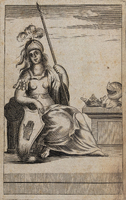
Heavily illustrated books on heraldry and emblem books had been popular for over a century when this item was printed. The engraved larger plates have been tipped in; smaller illustrations appear to be printed from woodcuts.
-
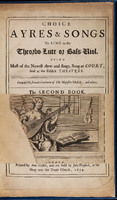
Anne Godbid and John Playford worked as partners to print music, a format which was considerably more difficult to produce than text. The music included in this volume was not composed by Playford, merely collected by him, and printed after the success of an earlier, similar book. While music printed from engraved plates began appearing in England in 1613, this music seems to be printed from movable type, using woodblock initials for ornamentation.
-
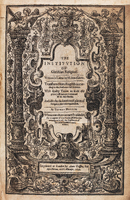
This seminal text by Calvin, in such a large format, was no small undertaking for any printer. Anne Griffin, as a relatively wealthy widow, was likely one of the few printers who could afford to do so, and in this case, took on partners as well. Joyce Norton (fl. 1632-37) was possibly the widow of John Norton, a printer who died in 1612. She also printed in partnership with Richard Whitaker (fl. 1619-48), a prominent bookseller.
-
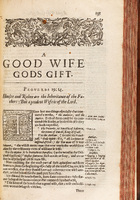
Another example of a moral sermon directed towards women. Edward Brewster (fl. 1621-1647) specialized in theological works. Fulke Clifton (fl. 1620-1644) specialized in broadsides and political pamphlets, which makes his commission of this particular work interesting. The notes are in Greek and Latin, easily accomplished by an established printing house such as Anne Griffin's, which would likely own several fonts of type.
-
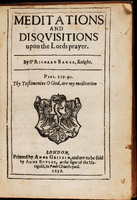
This text is another example of women working together to print and disseminate literature. Anne Boler (fl. 1635-7), continued the work of her late husband, James (fl. 1626-35), selling primarily theological works in St. Paul's Churchyard, one of the centers of printing and bookselling in London. Anne Griffin (fl. 1634-43) was the widow of Edward Griffin I (fl. 1613-21). In 1643, Griffin was reprimanded by the Company for publishing Thomas Becon's Displaying of the Popish Mass, an item which the Archbishop Laud, the sanctioned censor at the time, wished to repress.
-
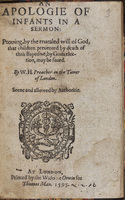
This sermon on baptism was likely aimed at a female audience-mothers who were urged to baptize their children. This book, printed by the Widow Orwin, was printed for Thomas Man (fl. 1576-1625), a prominent bookseller, highly active in the Company, who specialized in theological materials.
-
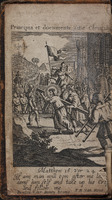
Mary Clark printed this moral instruction book for Henry Brome, who also worked with her late husband, Andrew. Joanna Brome, Henry's widow, later carried on his business.
-
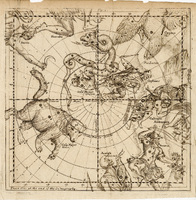
Our copy of this edition has had a great deal of conservation work, and was disbound. The book is notable for its maps and figures, which take a good deal of skill to print. Anne Godbid (fl. 1678-1683) was the widow of William Godbid, (fl. 1656-77) who, in partnership with John Playford, printed a good deal of music.
-

This book, which teaches "drawing, limning, and painting" is notable for the many engraved illustrations included. Margaret White (fl. 1678-83), the printer, is only listed briefly as a bookseller in Plomer.
-
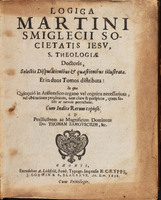
A scholarly book on logic with printed annotations in the margins. Anne Lichfield (fl. 1657-59) was the widow of Leonard Lichfield, the University printer at Oxford (fl. 1635-57). Leonard Lichfield was "a staunch Royalist, and was described in Puritan tracts as the 'malignant printer'" (Plomer 117). His imprint was frequently forged for books published in London. Upon his death, Anne and her son, also named Leonard, were appointed University printers.
-

A basic Latin textbook, which uses biblical passages to teach not only Latin but morals. Joanna Brome continued the bookselling and publishing business of her husband, Henry (fl. 1657-1681) for two years, until their son, who may have been either Charles or Henry Brome, took over.
-
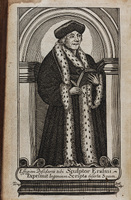
Erasmus's Colloquiorum was a standard scholarly text, reprinted many times. This edition contains a life and portrait of the author. Elizabeth Flesher (fl. 1670-1688) was the widow of James Flesher, and the daughter of Cornelius Bee (fl. 1636-71), a prominent bookseller. Her late husband, James (fl. 1652-67) was at one time proceeded against for illegally printing law books. James' father was Miles Flesher (fl. 1611-1664), a wealthy and prominent master printer, from whom he inherited the business.
-

Gertrude Dawson (fl. 1649-61) succeeded her late husband, John (fl. 1634-48). The Dawsons had inherited their printing house from John's father, also named John (d. 1634). The Dawsons were interested in fine printing: John Jr. owned among his ornaments a variation on an Aldine device; Gertrude had a new font of roman type cut for herself after taking over the business. This printing is a second impression.
-

This popular "how-to" text on animal husbandry and other household uses was sold by Hannah Sawbridge (fl. 1682-86), the widow of George Sawbridge the elder (fl. 1647-81). Sawbridge was a partner in the King's Printing House, treasurer of the Company of Stationers for much of his life, and Master of the Company in 1675. He left behind a good deal of wealth to his wife, and was known as one of the greatest booksellers in England at the time. Hannah continued the (quite lucrative) printing business until his son took over.
-
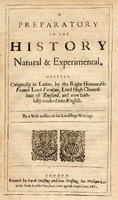
The Griffins were a printing family, part of a house originally founded in 1590. Sarah (fl 1653-73) succeeded her husband Edward II (fl 1638-52). Edward II had printed in partnership with his mother, Anne (fl 1634-43), and later succeeded her His father, Edward I (fl 1613-1621) was also a printer. Bennet Griffin is probably Sarah's son, who later restricted himself to bookselling and publication, rather than being physically involved with the printing of works like Bacon's Sylva Sylvarum.
-

Joan Orwin married three different printers in her life: John Kingston (1553-84), George Robinson (1585-7), and Thomas Orwin (1587-93). She continued the business from 1593 to 1597, when it was taken over by her son, Felix Kingston. The text is one of the standard histories of the period. Thomas Orwin's device, used by his widow, is visible on the title page, with the motto "By Wisdom peace by peace plenty." The book was likely sold by Joan Broome (fl. 1591-1601), widow of William Broome (1577-91); this is an early example of women working together in the printing trades.
-
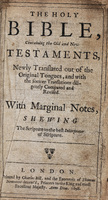
The executrix of Thomas Newcombe (fl. 1649-81) was his widow, Ruth (fl 1643-65, 1691-1700?) Newcombe was her second husband; she had also been widowed by another printer, John Raworth (fl. 1638-45). She continued the business from 1646 to around 1649, when she married Thomas Newcombe, who took over. In a 1668 survey, Newcombe's printing house was one of the largest in London. Newcombe was also a shareholder in the King's Printers. This closely printed Bible, produced after his death, was apparently a collaboration between the widow and Charles Bill (fl. 1687-1699), another of the King's Printers. According to Henry Plomer, Bill, although a shareholder in the King's Printers, never appeared to actually exercise the printing trade--which would mean that the production of the book was likely entirely directed by Ruth Newcombe.
-
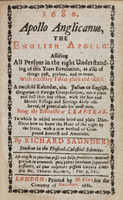
This almanac may have been "jobbed out" by the Company of Stationers to Mary Clark (fl. 1677-96), the widow of Andrew Clark (fl. 1670-78). Mary continued the business for nearly twenty years after her husband's death, and was quite prolific, printing almanacs, devotional literature, and the like, often for the Company of Stationers.
-

This book is one of the earliest in the collection printed by a woman. Elizabeth Redman, originally Pickering, was the widow of Robert Redman (fl. 1523-1540). She only printed a few works before remarrying, but is of note because she is one of the earliest documented widow printers in Great Britain. Robert Redman was a successor of Richard Pynson, (fl. 1492-1530); they were rivals while Pynson was alive, since Redman not only issued pirated editions of Pynson's works, but adopted his "sign" (i.e. address) as well.
-

Cavagna published this work on the portico of the Romanesque church of San Celso in Milan to promote its historic status and to prevent its destruction. His efforts were successful in part, although the façade of the church would be replaced in the 1890s. Found in this copy is a rare personal letter to Cavagna's first wife, Beatrice De Vecchi, to whom he was married from 1867 to 1885. In it, Cavagna humbly offers his "povarissimo" work to his "carissima Bice" and thanks her for her opinions on and edits to his writings.
-
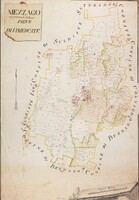
A hand-colored map of the city of Mezzago, in the parish of Vimercate, province of Milan, from the mid-eighteenth century.
-
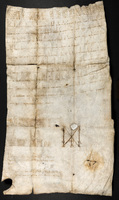
A charter on vellum from 1116 issued by Holy Roman Emperor Henry V granting privileges and imperial protection to the cities of Menaggio and Como; this document is the oldest in the collection and was displayed in 1936 in the first-ever Rare Book & Manuscript Library exhibition, then called the Rare Book Room.
-
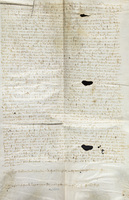
Original investitures and legal instruments on vellum, dating from the first quarter of the fifteenth century, with notarial signets.
-
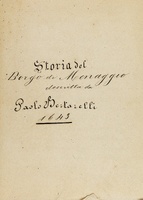
A history of the village of Menaggio described by Paolo Bertarelli.
-
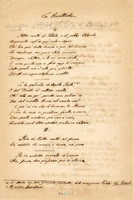
A late nineteenth-century unpublished poem by Giovanni Battista Bolza about risotto, in the style of the Aeneid.
























